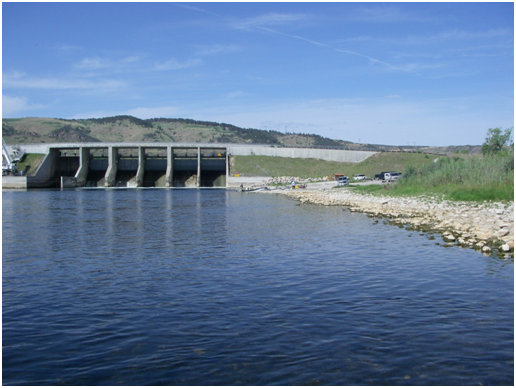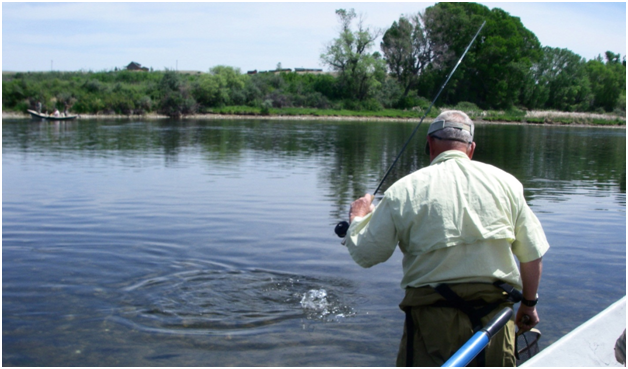FISHING THE HORN
Like a black snake, two lanes of asphalt snakes away in a generally southwesterly direction from the town of Hardin, Montana. The country rolls way like a green carpet toward the Big Horn River and the town of Fort Smith. It's roughly 40 miles from Hardin to Fort Smith, and the road takes you through miles of farm land where cock pheasants can be seen walking around in the alfalfa and sugar beet fields. This is Custer country, and with a bit of imagination you can picture smoke rising from campfires along the river and see tepees beneath the stately cottonwood trees. About half way to Fort Smith you pass through the town of St. Xavier, more of a wide spot in the road today, but at one time there was a large school there. Today it is an empty two story shell of concrete and broken windows. I always wonder what memories were made there when it was full of students.
Fort Smith, for those that have not had the pleasure of having been there, consists of several fly shops, a general store, Polly's Restaurant, and a collection of trailers and modest houses. There is even a small Baptist church, a sure sign of civilization. Most of the residents are either employed in the fishing business, serving the fishing business, or working for the Federal government at the Yellowtail Dam, which is right on the edge of town. The 2010 census indicated that 161 souls live in Fort Smith, which is 38 more residence than in 2000. Not exactly a population boom. However, I find Fort Smith to be a pleasant little town, and I always enjoy my visits there.
It has been a tradition for several years for my nephew and me to make a trip to the Big Horn in late May. While there have been a few gaps over the years due to personal issues, and last year you couldn't get there for a few days due to flooding, but over the last 20 years a fishing trip to the Horn in May has been a much anticipated event for us. It's always a treat to get to fish with my nephew because once he gets busy guiding I don't see him for weeks at a time. It seems hard to believe that once he was just a little stinker following me around like a puppy dog.

While Fort Smith is the home for several fly shops, I think the premier shop is The Bighorn Trout Shop owned by Steve Hilbers and Hale Harris and their wives. This shop has been my home away from home since the first time I went to the Horn and over the years I have greatly enjoyed the hospitality and great accommodations that the Bighorn Trout Shop offers.
This year we managed to arranged to fish two days on the Horn. We arrived early in the morning after leaving our home in Livingston at 5 pm. After a quick breakfast at Polly's we checked in at the Bighorn Trout Shop, picked up our room key, and arranged for someone to shuttle our vehicle from Afterbay down to Three Mile Access. It was a beautiful clear early summer/late spring morning when we launched the boat. The releases from Yellowtail Dam are low this year, especially after last year's high water, but at 2,000 cfs it really made the wading easy.

Looking upstream on the Bighorn River from below Afterbay
During the morning there were a few Baetis spinners and a minimal number of very small midges on the water. The Baetis spinners brought up a few fish along the shore just downstream from the launch site, and since this was the first fishing trip for me this season and my nephew's first fresh water trip since returning from his winter home in Florida, we spent the first half hour or so just putting rods together, changing leaders and generally fussing with tackle. After the tackle was assembled I slipped over the side of the boat and walked downstream about 75 yards to get below the rising fish and gradually worked my way back upstream, fishing as I went. I chose a size 20 dark Baetis spinner to match the ones that I saw on the water. I was using a 3 weight rod and a 10 foot leader, including the 5x tippet. I hook and landed the first three fish that I put the fly over, all nice browns in the 12 to 14 inch range. I must say that, after a winter of not picking up a fly rod, I felt pretty good about my first few casts of the new season. I could only pray that it will last.

A nice brown trout heading for the net
We slipped downstream and finally picked a bank where we could be out of the main traffic flow and wait for the Baetis hatch that we were anticipating would occur early in the afternoon. We were not disappointed as the flies began to hatch about 1:30 pm despite the bright sunshine. We fished for the next couple hours with a steady stream of hatching insects providing food for the rising brown trout.

As the afternoon progressed the sunny skies gave way to overcast with rain showers and gusty winds as a cold front pushed in from the north. The hatch began to wane by 4 pm and we moved further downstream hoping to find a few more rising fish before we called it a day. We managed to find a few more fish rising but only sporadically. We called it a day by 7 pm and headed back to the Trout Shop for a delicious hot evening meal.
The Bighorn Trout Shop not only has an excellent fly shop and guide service but they also offer excellent rooms and delightful dining. We joined a number of other guests in the dining room for a delight repast consisting of a half of a barbequed chicken, two tasty side dishes, a fresh crisp salad, rhubarb/strawberry pie with whipped cream, and coffee. With a full stomach we returned to our room for a good night's sleep.
The rain showers continued during the evening hours but it was only partly cloudy the following morning, and noticeably cooler than the previous day. After breakfast we launched our drift boat below Afterbay hoping that it would remain calm and that the rain would hold off until we were ready to call it a day and head for home. Given the fact that it was overcast and calm we anticipated that we would have a good midge hatch and that the Baetis hatch would start earlier than it had the day before. Neither of these projections proved true.
We floated downstream to the flat where we had fished the previous day and pulled in next to the shoreline to wait for the fish to start rising. While it was cool and overcast there were no midges, something that I found very unusual since the Bighorn is noted for its midge hatches and I had never been there before without encountering very heavy midge hatches. The water surface was virtually devoid of any kind of insect and only an occasional fish showed itself during the morning and early afternoon hours.
However, one is never without entertainment when fishing the Bighorn. There is a passing parade of boats, from drift boats to pontoons and prams, and they contain a varied collection of anglers.
In recent years I have observed an interesting phenomenon that I call circle fishing. This is an activity that is employed by some anglers, mostly guides, and involves floating down over a particular piece of water while the anglers fish with the standard Bighorn nymph rig that consist of; a large strike indicator attached at the top of a 9 or 10 foot leader with a weighted nymph and perhaps a dropper tied on the tippet. This form of fishing requires only minimal casting and fly fishing skills but produces a steady stream of hooked fish for the anglers. When the guide finds a particularly productive piece of water where the fish are 'stacked up' they float down through the section and then row back up and repeat the process again and again. It is not unusual for each drift to produce a couple fish and doubles, where both the anglers in the boat have a fish on at the same time, are not unusual. We watched two boats on the opposite side of the river from where we were sitting, both operated by guides, float down and row back up a piece of water all morning long that was approximately 50 yards long! Their clients were continually hooking and landing fish and there was an ongoing competition between the two boats, which apparently contained friends, and they maintained a running count of number of fish caught and their size. [Which was approximate since I never saw any fish actually measured] They arrived about 10 am and did not leave until around 2 pm. Although the area they fished varied slightly during the course of the time they were there, they never covered more than 75 yards of river but they caught and released 50 or 60 fish between the two boats. Not my idea of a good time but the clients sure seemed to be happy.
It's clear that not all guides or anglers follow this manner of fishing, but what I have described above is a common occurrence on the Bighorn. The Bighorn is noted for its quality angling and the size and difficulty of its wild trout population. The fish that these anglers were catching were all wild, stream raised brown trout and most of them, from what I could observe, were in the 12 to 18 inch size range. The degree of difficulty that it took to hook those wild trout was equivalent to lobbing a gob of worms with a bait casting rig. I always think of that when I hear anglers talking about the great degree of skill it takes to hook a wily wild brown trout. Watching those guys catch a boatload of trout using those tactics certainly can knock the wind out the biggest egotist's sails. This is not to suggest that you can't find challenging fishing on the Bighorn, and many fine anglers can be encountered fishing small flies on fine tippets to browns and rainbows that will test the skill of any angler.
While we were being entertained by the passing or not so passing parade of anglers we continually watched for the hatch that we were certain was going to appear, but rather than coming early the first Baetis did not start appearing until around 2:30 pm, almost one hour later than the previous day. However, when the hatch came it has heavy and the fish immediately began to respond. It was interesting to note that during the hatch my nephew was using a hackle-stacker dry and a wet Baetis soft hackle for a dropper, while I was using a sparkle dun without any dropper and we both were getting consistent takes except on different flies. He caught all his fish on the soft hackle while, using only the sparkle dun, I matched him fish for fish.
Once again the rains came but with a bit more ferocity than the previous day and the hatch stopped as quickly as it had begun. A cold wind began to blow out of the north and we quickly struck out for the access and a warm dry vehicle.
If you have never experienced Montana's Bighorn River you have missed a great angling experience. In addition, the scenery, especially along the river, is beautiful. In the spring of the year the streamside vegetation is filled with several species of birds, six species of swallows are present in uncountable numbers, along with numerous warblers, robins, gray catbirds, and orioles – just to name a few of the species that are easily seen while floating the river. The hatches have to be seen to be believed, and the number of good fish that are available boggles the mind. I come for the fishing, but mostly I come for the total experience of being in such a special place. I hope that you too will plan a trip to Montana's Bighorn River sometime in the near future.
| Editor's Note |
|---|
| You can check out the Bighorn Trout Shops website by visiting FAOL's sponsor page. |
